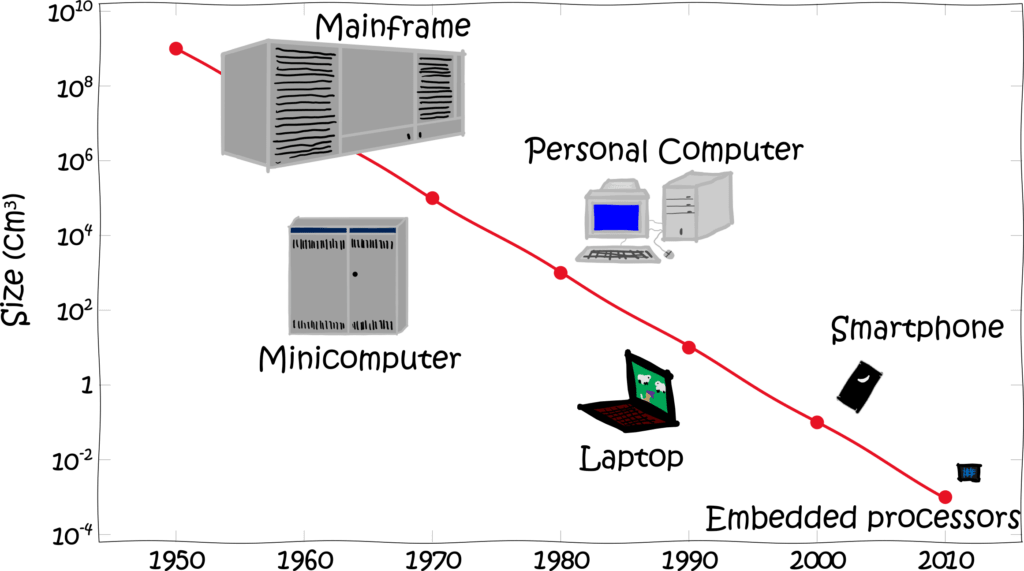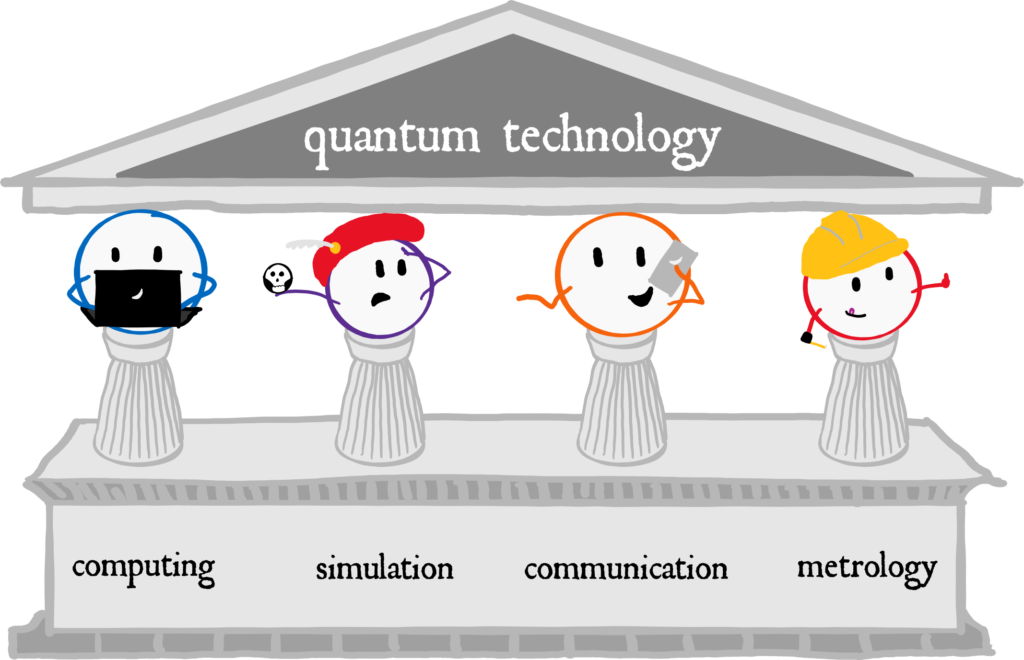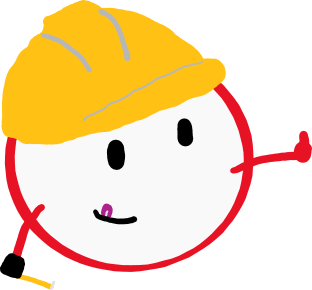When you think of quantum technology, you think of quantum computers. Or science fiction, light sabres and half-dead cats. But quantum technology is more than the chase for the quantum computer. The second quantum revolution is about breaking boundaries and taming nature’s smallest building blocks. What emerges is a superlative technology: smaller, faster, safer, more precise. And not to forget: more incomprehensible.
But the road to quantum computers and co. was long. The first quantum revolution took place at the beginning and middle of the 20th century. Quantum theory had just been discovered, which threw the whole of physics into turmoil. The newly discovered wave-particle dualism had far-reaching consequences for the development of technology. Solar cells, microchips, computers, lasers, GPS – we owe them all to the first quantum revolution. But the technology behind all these devices is relatively simple. I (and probably many others) already made a solar cell in chemistry class.
Today we are at a turning point – in the second quantum revolution. Instead of just calculating the shape of electron orbitals, we want to shape orbitals that do not exist in nature. Instead of just understanding the structure of atoms, we want to build our own atoms. Instead of just using quantum physics to explain technology, we want to fully exploit its potential. We no longer see nature as a Lego box but rather knead the world as we like it.
Moore’s Law
Besides pure curiosity on the part of physicists, this development also has very practical reasons: our technology is reaching its limits. In fact, this is not just a vague feeling but it can be made concrete with the help of Moore’s Law.
Gordon Moore is an American scientist and co-founder of Intel. In 1965, he made an observation that would shape the development of technology to this day. The microchip had been developed 7 years earlier and Moore studied the trend of research. He discovered:
The number of transistors that fit in a microprocessor of a given size doubles roughly every two years.
Moore’s Law
Impressive, isn’t it? Okay, let me explain.
The transistor
A transistor is the heart of a processor; it is the part that computes. You could say that what neurons are to the brain what transistors are to the processor. Moore says the number of transistors per chip doubles every two years. Conversely, this means that the size of a transistor halves. The size of the chip remains the same in this comparison, of course, because otherwise you could double the size of the chip and be done – that’s not what is meant. So Moore found that every two years on average, researchers manage to split all the transistors on a chip in two, with each of the new transistors being just as strong as the previous one.

A few marginal notes on this. Moore’s law is of course not a law in the strict sense; it is an observation. Moreover, doubling the number of transistors does not necessarily mean doubling the computing power. A smaller transistor is not always as good as its big brother. And lastly, pause for a moment and reflect on the meaning of Moore’s Law. It means that research is progressing at breakneck speed and that the computing power of computers is growing exponentially (the word “exponential” has probably become familiar to most people since the Corona pandemic at the latest).
Miracles and future visions
Moore’s essay turned 55 in April and reads a bit like Jules Verne’s “20,000 Leagues Under the Sea“. Written in 1870, Vernes envisioned a world with electricity, submarines, and aeroplanes that was amazingly close to the actual future. In 1965 – when computers still filled entire wardrobes – Moore spotted a trend. In his essay, he predicted miracles: Home computers, automatic controls for cars and “personal portable communication devices”. The latter we now call mobile phones.
Moore’s law, which he said would describe the trend of the next 10 years, has retained its validity for half a decade. But it didn’t just predict the development in the semiconductor industry, it drove it. It is no coincidence that CPU developers bring new, better models to market every two years. People wanted to live up to Moore’s Law. It was a self-fulfilling prophecy. But for a few years now, the rapid pace has been stalling – Moore’s Law is about to come to an end.
The problem is the size of the components. All matter consists of atoms and at some point a component is so small that it consists of only a few – or even single – atoms. That may sound extreme, but that is exactly where we have arrived. And in the world of atoms, quantum physics reigns supreme, shaking things up.
The four pillars of quantum technology
One of the main concerns of the second quantum revolution is to make technology smaller. We need quantum physics for this because it can no longer be done in the “normal” way. The other concern is to make technology better. One example is indeed the quantum computer. But there is so much more! Let me present to you the four pillars of quantum technology.

Quantum computing

The quantum computer is the flagship of quantum technology. Presumably because it can solve many of the other problems, too. A normal computer calculates with bits, i.e. zeros and ones. Every computer problem – from calculators to computer games – is broken down into many arithmetic operations that juggle zeros and ones. But a quantum computer does not only deal with zeros and ones – it also knows everything in between; in the form of superpositions. The highlight of a quantum computer is that it can perform many calculations simultaneously, instead of laboriously one after the other. This speeds up the quantum computer (exponentially!) and renders impossible calculations possible.
Quantum simulation
In principle, a quantum computer can solve any problem – you just have to describe it correctly. Instead of bludgeoning a problem with a quantum computer, however, you can also try to solve it more elegantly. That is the basic idea of quantum simulation.

The most important tool of physicists are experiments. In the simplest case, you can do experiments directly on the object you are interested in. If I want to know how fast an object falls, I drop it and measure the time. Done. But what if the system I want to learn about is too complicated or I can’t influence it? The solar system, for example. How do astrophysicists do experiments? They can’t really change the arrangement of the planets and see what happens. Instead, they build models of the solar system and study them instead.
Exactly the same thing happens in quantum simulation. Instead of directly investigating a large, complicated system systematically – which is often plain impossible – I build a smaller model that I can control. The small quantum system acts as if it were the big one. In the world of quantum physics, the whole thing also has another advantage: instead of teaching a classical model the rules of quantum physics, I build a model from quantum parts that behave quantum mechanically on their own. The quantum simulator does all the work for me; I just have to sit back and wait to see what comes out. Developing a quantum simulator for a specific problem is easier than building a quantum computer. The disadvantage, however, is that the quantum simulator only works for that particular problem. It is useless for other problems.
Quantum communication

We don’t observe quantum effects in everyday life because quantum states are little divas and very fragile. In many fields this is bad but for quantum communication it is the key to success.
Imagine you want to send a message and you put it into a bottle. Someone could intercept the bottle, read the message, put it back and send it on its way. Neither you nor the recipient would ever know that someone had read the message. But there are ways to protect your messages. You could, for example, seal the bottle with wax or encrypt the message. But the enemy does not rest and as the complexity of encryption techniques increases, so does the skill of the eavesdropper.
An absolutely secure way to protect the message in the bottle would be to write it down on a paper that bursts into flames as soon as you read it. This is the basic idea of quantum cryptography, a branch of quantum communication. Messages are transmitted with the help of quantum systems, for example in the form of photons. Because of the way the message is encrypted, it is impossible to send exactly the same message again after it has been read. This makes message transmission 100% tap-proof.
Quantum metrology

Probably the least known area of quantum technology is quantum metrology. This is not about weather forecasts but about measurements (metrology as in measurement technology, not meteorology as in weather). High-precision measurements are needed in many areas of (more or less) everyday life. First and foremost, quantum technology itself. When working with such delicate flowers as quantum systems, it is no longer sufficient to determine the strength of errant magnetic or electric fields approximately. However, one can turn the sensitivity of quantum systems into an advantage if one uses them to determine the strength of these quantities with high precision.
A current example of very precise measurements is the detection of gravitational waves, which won the Nobel Prize in 2017. The precision of the LIGO detector for gravitational waves can be significantly improved using quantum metrology methods. This is also a nice example that quantum technology is not always small. The two observatories of LIGO are 3000 km apart and each measuring apparatus has a length of 4 km. This device can measure length differences of a thousandth of a proton radius – sensitive enough to sense the effects of gravitational waves.
This list is only intended to give a rough overview of the areas of quantum technology – each of the four points deserves its own article. However, they have one thing in common: they are not yet fully developed. They are subject to current research and exist at most in laboratories under extreme conditions. So, unlike technologies of the first quantum revolution, they do not yet exist in your pocket or in your household. In part, it is even uncertain whether they will ever exist. But we are optimistic! Who would have thought 70 years ago that today we all carry small high-performance computers in our pockets and have lasers at home to watch amazingly realistic films about talking lions?
In summary, Moore’s Law may be at an end, but technology is not. Instead of trying to fulfil a prediction from the 70s, a shift is taking place. Instead of size, people are focusing on more important things: performance, safety, precision. But perhaps quantum technology is just a useful by-product of scientific curiosity. What is possible? How far can we go? Can we do better? Quantum theory allows us to control the smallest particles at a whole new level. What happens when physicists play with modelling clay instead of Lego?
We will soon find out.
Do you like what you read? Then maybe you are interested in the article about the first quantum revolution. Subscribe to my blog to not miss out on any new post!
References:
Jonathan P. Dowling, Gerard J. Milburn – Quantum technology: the second quantum revolution.
Gordon E. Moore – Cramming more components onto integrated circuits
M. Mitchell Waldrop – The chips are down for Moore’s law, Nature

